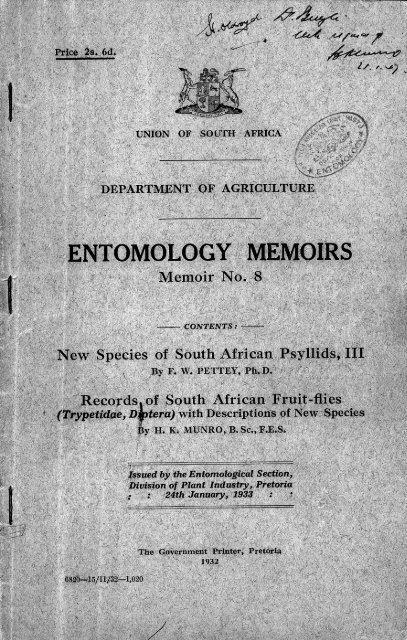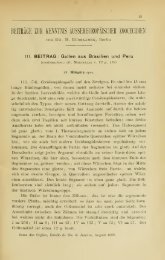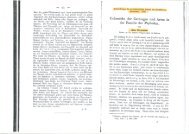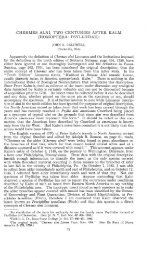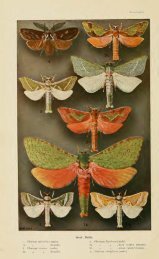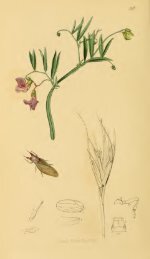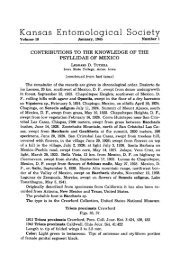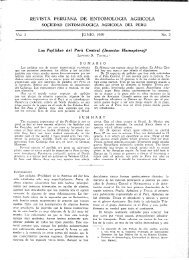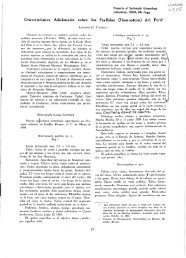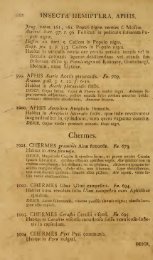ENTOMOLOGY MEMOIRS
ENTOMOLOGY MEMOIRS
ENTOMOLOGY MEMOIRS
Create successful ePaper yourself
Turn your PDF publications into a flip-book with our unique Google optimized e-Paper software.
Price 2s. 6d.<br />
UNION OF SOUTH AFRICA<br />
DEPARTMENT OF AGRICULTURE<br />
<strong>ENTOMOLOGY</strong> <strong>MEMOIRS</strong><br />
Memoir No. 8<br />
CONTENTS:<br />
New Species of South African Psyllids III<br />
By F. W. PETTEY, Ph. D.<br />
Records of South African Fruit-flies<br />
(Trypetidae, D tera) with Descriptions of New Species<br />
By H. K. MUNRO, B. Sc. F.E.S.<br />
Issued by the Entomological Section,<br />
Division of Plant Industry, Pretoria<br />
24th January, 1933<br />
The Government Printer ,<br />
1932<br />
Pretoria<br />
6820-15/11/32-1,020
NEW SPECIES OF SOUTH<br />
PSYLLIDS III.*<br />
By F. W. PETTEY, Ph.D., Senior Entomologist,<br />
Division of Plant Industry.<br />
AFRICAN<br />
THIS article contains descriptions of new species of Psyllidae collected<br />
by the writer. The types and paratypes may be found in the collection<br />
of the Division of Plant Industry, Entomology Section.<br />
Lsco.,..444....s.<br />
Psylla distincta, sp. nov.<br />
[Pl. I, figs. 1, 2, 21 (a) (b), 24; Pl. II, figs. 39, 40.]<br />
General colour of specimens in alcohol pale yellow, with posterior<br />
margin of vertex, anterior margin of pronotum, entire margin of<br />
praescutum brownish, eyes dark brown. One specimen of the ten<br />
examined has a brownish head and thorax with the posterior margin<br />
of the vertex, the whole of the pronotum, the margin of the praescutum<br />
and of the scutellum, and the tip of the genitalia dark brown.<br />
The male is similar to the female in colour.<br />
Head : Considerably deflexed, including eyes, broader than<br />
praescutorn but not quite as broad as scutellum. Vertex in dried<br />
specimens almost twice as wide as long, with a shallow, distinct<br />
somewhat quadrate fovea on the middle line of each half posterior to<br />
the centre of each half, not pubescent or if so very finely pubescent,<br />
posterior border distinctly emarcdnate, with the anterior border near<br />
the middle suture somewhat bulging in dried specimens; genal cones<br />
almost as long as vertex, divergent, subacute, coarsely pubescent,<br />
the conspicuous setae not very numerous. Antennae long and slender,<br />
the basal seven segments as long as or somewhat longer than the<br />
hood and thorax combined and longer than twice the width of the<br />
head, the third segment longest, the fourth about two-thirds as long<br />
04 the third, the three terminal segments missing in the specimens<br />
available for inspection.<br />
Thorax : Strongly arched, with no or very minute pubescence.<br />
Logs slender ; hind tibia very nearly as long as femur, with a small<br />
1)114111 spur (easily visible in a balsam mount, but not easily visible<br />
w Mt binoculars), and with five rather stout dark brown spines on the<br />
nm,rgin.at the apex two of which are more close together than the<br />
other ; basal segment of the hind tarsi with two spines at the apex;<br />
motto:mail spurs not very large, conical. Fore-wings large, hyaline,<br />
ntosl hree times longer than wide; pterostigma present, somewhat<br />
opal ne, long; veins hairless, marginal cells fairly large, the first<br />
IsinTs, —This article is designated as New Species of South. African Psyllids<br />
I I I New South African Psyllids II may be found in The South African<br />
1)11111111 of Natural History V, 195, pp. 125-142, Pl. XII, XIII. South African<br />
I may be found in Entomological Memoirs No. 2, Department of<br />
Altripulinro, Union of South Africa, 1924, pp. 21-30, P1. I, II, III.
somewhat longer than the second, R + M+ Cu not quite straight, the<br />
claval suture almost attaininu the tip of Cu 2, venation as in figure<br />
la. Hind-wings large, about one-third shorter than the fore-wings;<br />
hyaline; venation as in figure lb. Male genatalia pubescent ; forceps<br />
somewhat conical, slightly toothed or chitinous at apex, shorter than<br />
anal valve, which laterally is about twice the width of the forceps,<br />
and tapers somewhat at the apex. Female genitalia a little more<br />
than half the length of the rest of the abdomen, pubescent ; dorsal<br />
valve rounded at apex, pubescent, with two or three long setae on<br />
each side; ventral valve pubescent, slightly shorter than the dorsal<br />
valve and pointed at the apex,<br />
Measurements : Length of body, male 2 mm. ; female 2.8 mm.<br />
Width of head including eyes, male .6 ram. ; female .7 mm. Length<br />
of fore-wing, male 2.9 mm. ; female 3.11 mm. Width of fore-wing,<br />
male 1 mm.; female 1.12 mm. Length of hind-wing, male 2.02 ram. ;<br />
female 2.03 mm. Width of hind-wing, male .8 mm.; female .81 mm.<br />
Locality and collector doubtful, but probably collected by the<br />
writer by sweeping veld bushes in the western district of the Cape<br />
Province, 1923. Described from two males and two females.<br />
Paurocephala hottentotti, sp. nov.<br />
[Pl. I, figs. 3, 4, 22 (a) (b) (a); Pl. II, figs. 41, 42, 43.]<br />
Colour of dried specimens : Yellow, except the two apical segments<br />
of the antennae, the apical spines of the posterior tibiae and<br />
spines of the basal posterior tarsi, which are dark brown to black,<br />
and the apex of the female genitalia, which is brownish. Ocelli<br />
reddish, eyes, dark brown.<br />
Head of female, including the eyes, about as broad as widest<br />
part of thorax, and almost three times wider than the length of the<br />
median line of the vertex. Vertex flat, wider than long, almost<br />
quadrate, with a shallow fovea in each half near the middle and near<br />
the posterior margin, finely pubescent, posterior margin deeply<br />
emarginate, on the same plane as genae, somewhat deflexed. Genae<br />
finely pubescent, with one or two longer setae located ventrally on<br />
each, somewhat swollen, rounded downwards, and retracted towards<br />
the thorax. Frons visible ventrally, somewhat depressed between<br />
the genae, with anterior ocellus at the apex on the same level as the<br />
vertex and just visible when the vertex is viewed dorsally. Antennae<br />
shorter than length of head and thorax, and somewhat longer than<br />
the width of the head including the eyes, slender, the tenth segment<br />
shorter and narrower than the ninth, and with two apical spines, the<br />
one slightly shorter and stouter than the other and less pointed at<br />
the tip, the third segment about as long as the 4th to the 7th inclusive.<br />
Eyes large, somewhat recessive.<br />
Thorax : Fairly thick dorso-ventrally, fairly well arched, more<br />
finely pubescent than head, two very small circular foveae, one on<br />
each side of the pronotuna, posterior to the eyes ; posterior lateral<br />
angles of the praescutum not prominent, middle line of scutum not<br />
distinct; propleurites rather lonff. Legs comparatively slender, hind<br />
tibiae without basal spur, with six stout black spines at the apex,<br />
three on the inner and three on the outer margin ; metacoxal spurs<br />
rather small, conical, not very slender.<br />
4<br />
5<br />
Fore-wings comparatively long, narrow, rounded at the apex,<br />
widest some distance before the apex, hyaline. All veins and margin<br />
of wing with two rows of minute hairs visible only with high power<br />
of microscope ; pterostigma long and narrow with scattered equally<br />
minute hairs; R, M + Cu, Cu and R + M + Cu sub-equal and rather<br />
long. Hind-wings : Venation as figured, vein Car, wanting in the<br />
specimens examined.<br />
Measurements : Length of body, male 1.35 mm , female 2 ram. ;<br />
length of fore-wing, male 1.45 mm., female 2 mm.; width of forenaale<br />
.65 mm , female .8 ram.; length of hind-wing, male<br />
1.35'' mm., female 1.7 mm. ; width of hind-wing, male .5 mm., female<br />
.6 mm ; width of head, male .5 mm , female .64 mm ; length of<br />
antennae, male .75 mm., female .75 mm.<br />
This species resembles Paurocephala bicarinata Pettey with<br />
respect to the wing venation of the fore-wings and to the male genetalia.<br />
In other respects, however, it differs considerably from the<br />
latter.<br />
Collected on Brabeum, stellatifolium (Hottentots' almond), at<br />
Jonkershoek, Stellenbosch, Cape Province, 20th December, 1922.<br />
It causes galls on the leaves of this shrub. Described from three<br />
males and three females.<br />
Arytaina karrooensis sp. nov.<br />
[Pl. I, figs. 5, 6, 23 (a) (b); Pl. II, figs. 44, 45 (a) OM<br />
Colour (specimens in alcohol) : Head, pronotum except sides,<br />
including the two foveae, praescutum except lateral margin,<br />
scutellirra, legs and abdomen yellowish. Eyes, lateral margins of<br />
pronotum anddb praescaturn and metathorax brownish, metacoxal spurs<br />
pale yellow. Scutum brown, with a broad median longitudinal<br />
yellow stripe and two narrow lateral longitudinal yellow stripes on<br />
each side. Antennae pale yellow, except the two basal and two apical<br />
segments, which are brown, the third to the eighth segments inclusive<br />
dark brown at the apex.<br />
Head (specimens in alcohol), including eyes about as broad as<br />
widest part of thorax, somewhat deflexed, thorax somewhat but not<br />
highly arched. Vertex flat, about one-third wider than the length<br />
of the median line, lateral margins straight between the eyes,<br />
narrower anteriorly, posterior margin emarginate, finely pubescent,<br />
with two small inconspicuous circular foveae on each side of the<br />
median line; genae produced into short, broadly conical processes,<br />
which are as wide as long, coarsely pubescent, each with one very<br />
long ventrally located seta. Eyes comparatively small, slightly<br />
recessive, posterior ocelli bordering posterior margin. Antennae<br />
slender, considerably longer than head and thorax combined, the<br />
last two segments (9th and 10th) practically as slender as the preceding<br />
ones, at least three times longer than wide, the two combined<br />
longer than the eighth. The tenth segment one spine, but possibly<br />
a second may have been broken off (only one antenna available for<br />
examination).<br />
Thorax broad, arched, finely pubescent. Pronotum about half<br />
the length of the vertex, with two circular foveae on each side, the<br />
innermost ones posterior to the ocelli and considerably smaller than
6<br />
the outer ones ; praescutum with long, acute angles at the anterior<br />
lateral margin when viewed dorsally. Legs : Hind tibiae with small<br />
yellowish rather blunt spur at the base, visible with low power of<br />
binocular, and with four dark brown spines at the apex, three on<br />
the inner margin and one on the outer; metacoxal spurs of medium ,<br />
size, acutely conical at tip.<br />
Fore-wings hyaline, rather wide and short, outer margin well<br />
rounded, outer third maculated with brownish more dense maculae<br />
distributed as figured; pterostigma long, with scattered minute hairs.<br />
Costal margin of wing with small hairs ; outer and inner margin<br />
with hairs invisible except with high power of microscope, and then<br />
seen with difficulty; veins with double row of fairly conspicuous<br />
hairs, visible with high power of binoculars; first marginal cell much<br />
longer and wider than the second; R, M + Cu considerably longer<br />
than R, and more than twice as long as M + Cu. Venation of hindwing<br />
as illustrated.<br />
Abdomen fairly coarsely but sparsely pubescent. Female<br />
genitalia : Coarely pubescent, with several long lateral setae on the<br />
dorsal valve before the apex, and with several somewhat shorter setae<br />
on the ventral valve before the apex, which are longer than the other<br />
setae on the ventral valve. Ventral valve, viewed laterally, shorter<br />
and wider and more pointed at the apex than the dorsal valve.<br />
Measurements : Female, length of body 2.2 mm. ; length of forewing<br />
2.25 mm. ; width 1 mm ; length of hind-wing 2 mm. ; width<br />
.85 mm.<br />
Collected on Acacia karroo at De Dooms, Cape Province, 5th<br />
of February, 1923 ; at an elevation of about 2,000 feet. Described<br />
from one female and one male.<br />
Arytaina capensis sp. nov.<br />
[P1. I, figs. 7, 8 ; Pl. II, figs. 30 (a) (b) (a), 46, 47, 48.]<br />
Colour of dry specimens : Abdomen and legs yellowish and<br />
genitalia greenish. Vertex, genae, three basal segments of the<br />
antennae, and basal half of the other antennal segments, except the<br />
tenth, pale yellow, apical half of fourth to tenth antennal segments<br />
black or brown, tenth segment black. Eyes dark brown, ocelli reddish.<br />
Pronotum yellowish with foveae brownish, anterior margin of<br />
praescutum brownish with median stripe and lateral angles yellow,<br />
scutum brownish with two lateral black lines in some specimens on<br />
each side of middle, extending forward from the posterior margin<br />
but not attaining the anterior margin and widest near the posterior<br />
margin, scutellum of metathorax greenish in some specimens. Metacoxal<br />
spurs whitish. Genitalia of male and of female greenish<br />
female genitalia brown at apex.<br />
Head, including eyes, as broad as widest part of thorax, somewhat<br />
dellexed, thorax somewhat but not highly arched. Vertex (in<br />
dried specimens) almost flat, somewhat wider than long and narrower<br />
anteriorly than posteriorly, with a small circular fovea near the<br />
centre and posterior margin of each half extending towards the<br />
anterior, forming a narrow linear groove, very finely pubescent,<br />
posterior margin deeply emarginate, genae produced into subconical<br />
ol gent processes extending in same plane with vertex but<br />
He im raged from the vertex by an impressed line, rounded at apex,<br />
coarsely pubescent, about half as long as vertex. Eyes large, slightly<br />
recessive. Antennae moderately long, slender, extending back farther<br />
than the posterior margin of the tlTorax, the third segment about as<br />
long as the fourth and fifth combined, the fourth to seventh inclusive<br />
sub-equal in length, and longer than the eighth, the ninth and tenth<br />
shorter and broader than the third to the eighth and together about<br />
eil nal in length to the eighth ; two stout setae at the tip of the tenth<br />
segment, the one somewhat stouter and shorter than the other.<br />
Thorax broad, arched, finely pubescent. Pronotum with two<br />
cider foveae on each side, the innermost almost directly posterior<br />
to the ocelli. Legs fairly long; hind tibiae with a very small<br />
yellowish spur at the base, just visible with high power of binoculars,<br />
and with about ten dark brown spines at the apex; basal tarsal segment<br />
with two dark brown spines at the apex; metacoxal spurs rather<br />
long, conical.<br />
Fore-wings hyaline, brownish in the area bordering vein Cu„<br />
with a very long, narrow, opaque or subcoriaceous pterostigmai, which<br />
is pubescent on the costal margin; veins with double row of fine<br />
setae, venation as figured. Hind-wings as figured.<br />
Abdomen coarsely pubescent. Male genitalia pubescent ; forceps<br />
shorter than anal valve, finger-like ; anal valve much wider than<br />
'forceps, converging greatly towards the apex, lateral aspect as<br />
figured. Female genitalia as long as rest of abdomen, pubescent_;<br />
dorsal valve subacute at apex, longer than the ventral, valve, which<br />
is more pointed at apex.<br />
Measurements; Length of body, male 2.3 mm.; female 2.7 mm.<br />
Width of head including eyes, male .7 mm. ; female .75 mm Length<br />
,<br />
of fore-wing, male 2.75 ram. ; female 3.4 mm. Width of fore-wing,<br />
male .95 mm. ; female 1.1 mm. ; length of hind-wing, male 2.2 mm.<br />
female 2.35 mm. Width of hind-wing, male .72 mm. ; female .8 mm.<br />
Collected on Rhus sp. at Waterfall, Groot Drakenstein, Cape<br />
Province, December, 1922. Described from two males and five<br />
females.<br />
Euphalerus valens sp. nov.<br />
[Pl. I, figs. 9, 10, 29; Pl. II, figs. 31 (a) (b), 49, 54, 55.]<br />
Colour of dried specimens : Vertex of head, pronotum, praescutum<br />
and scutum of thorax, and genitalia yellowish brown. Genae,<br />
abdomen, legs and whole ventral surface of body, including head, pale<br />
yellow to white. Eyes, anterior and lateral margins of scutellum,<br />
pox of female genitalia, apex of forceps, spines of hind legs dark<br />
brown, to black. Ocelli reddish orange. The scutum is indistinctly<br />
rked with two broad, broken, brown lines.<br />
Head (dried specimens) of female, including the eyes, distinctly<br />
narrower than the thorax and about three times wider than the<br />
'Novi 11 of the median line of the vertex, considerably deflexed.<br />
Vertex punctate, rather flat, but somewhat swollen on each side of<br />
the median line, subquadrate, the sides straight between the eyes,<br />
converging to front, truncate at front margin, broader than long,
9<br />
with two linear foveae, the deepest part of which is circular and<br />
near the posterior margin, posterior margin emarginate, on the same<br />
plane as genae, coarsely pubescent. Genae coarsely pubesc ent, short,<br />
about as wide as long, conical or subacute at apex. Clypeus small.<br />
Antennae slender, short, about as long as width of head, the three<br />
terminal segments black to brown, wider than the others except the<br />
two basal, the tenth segment shorter and narrower than the ninth<br />
and with two terminal unequal spines, the third segment about, as<br />
long as the fourth to the seventh inclusive.<br />
Thorax: Stout, very convex transversely and longitudinally,<br />
punctate; propleurites rather long, the episternum distinctly swollen;<br />
pronotum and praescutum coarsely pubescent, the pronotum swollen<br />
at lateral margin in form of a knob; scutum more finely pubescent,<br />
very broad and convex. Legs slender, hind tibiae without basal spur,<br />
with about ten stout black spines at apex; metacoxal spurs slender,<br />
conical, not very large.<br />
Wings : Fore-wings not very long, rounded apically, subopaque,<br />
with two transverse bands near the apex, one of which is dark brown<br />
and the other white; two similar transverse bands at the base of the<br />
wing. Pterostigma present, rather narrow, long, with scattered<br />
small hairs. All veins and margin of wing have two rows of small<br />
hairs sufficiently large to be visible through the binocular ,• first<br />
marginal cell distinctly shorter and wider than the second. ifindwings,<br />
venation as figured, Cu, wanting, Cu does not join M.<br />
Genitalia : Female genital segment a little longer than rest of<br />
abdomen, dorsal valve slightly longer and less pointed than the<br />
ventral, coarsely pubescent, with three or four lateral, long setae<br />
before the apex; ventral valve coarsely pubescent. Male genitalia;<br />
forceps a little longer than anal valve, shaped more or less like a<br />
knife blade, long and narrow, narrower apically than basally,<br />
coarsely pubescent, but with shorter setae than the anal valve; anal<br />
valve coarsely pubescent, with setae longest on posterior margin,<br />
narrower and truncate at the apex, widest in the middle.<br />
Measurements : Female, length of body 2.2 mm. ; length of forewing<br />
2.3 mm.; width 1.1 mm. ; length of hind-wing 1 85 mm ; width<br />
.8 mm ; width of head, including eyes, .7 mm.; length of antennae<br />
.7 mm.<br />
This species has been placed in the genus Euphalerus Schwarz<br />
rather than in Diaphorina Lw. because the thorax is strongly arched,<br />
as the tegminae are more rounded and less linear than those included<br />
in the latter genus. The head, although not quite so approaching<br />
to the vertical as other representatives of Euphalerus, is more<br />
depressed than most species included in Diaphorina Lw.<br />
Described from two males and two females collected on the tree<br />
Gymnosporia laurina on Mitchell's Pass, Cape Province, at an altitude<br />
of about 1,000 feet, 20th January, 1923.<br />
Diaphorina quadramaculata sp. nov.<br />
{Pl. I, figs. 11, 12, 26; Pl. II, figs. 32 (a) (b), 50, 51.]<br />
Colour of dried specimens : Head yellowish, ocelli reddish, eyes<br />
dark brown. Pronotum yellowish, praescutum yellowish, with two<br />
large subconical dark brown areas in the centre of the anterior<br />
scutum yellowish with two wide, brown, longitudinal stripes,<br />
on each side of the middle, each brown stripe divided in the<br />
middle by a narrow more or less distinct yellow longitudinal line;<br />
moll ell um and other posterior dorsal segments of the thorax pale<br />
yellow, lateral sclerites dark brown. Dorsal segments of abdomen<br />
mid mita valve of female genitalia dark brown to black, ventral seg-<br />
;limits of abdomen yellowish, ventral segments of female genitalia dark<br />
brow n at apex, yellowish brown at base. Antennae yellowish, except<br />
ihe two terminal segments, which are dark brown. Metathoracic spurs<br />
yellowish at tip, dark brown at base. Legs yellowish, except femora<br />
of middle- and hind-legs, which are brownish. Fore-wings subhyaline,<br />
with IL four distinct dark brown spots located as figured, and with four<br />
nil her indistinct white areas on the inner margin of the' wing, the<br />
largest; at the tip of vein Cu 2, and each of the others more linear (riot<br />
11; tin to) respectively in the centre of the first and second marginal cells,<br />
timl coil M, all on the margin of the wing. The head and thorax are<br />
covered with a white mealy-like secretion.<br />
Head : Somewhat deflexed, punctate, including eyes, somewhat<br />
na rrower than widest part of thorax. Vertex about one and a half<br />
I i mos wider than the length of the middle line, fiat, punctate ; pos-<br />
1 erior border not very deeply emarginate, a small linear fovea in<br />
each half near the middle, the deepest part forming a tiny circle<br />
Iota led posterior to the center, coarsely pubescent. Genae on same<br />
(.‘ el as vertex, directed forward, contiguous for about half their<br />
length, at least a third longer than wide, subconical at tip, coarsely<br />
riled conspicuously pubescent, with setae slightly longer than or about<br />
Ils long as on the vertex. Antennae shorter than width of head,<br />
including eyes, slender, the two terminal segments wider than those<br />
preceding, with two setae at the apex, one at least three times longer<br />
n. nd more pointed than the other ; segments subequal in length, the<br />
third a little longer than the rest, the two last the shortest and<br />
tie idest, the fifth and seventh the narrowest. Eyes slightly recessive,<br />
of medium size.<br />
Thorax somewhat arched, of medium breadth and depth, finely<br />
end distinctly punetate, pubescent, with setae shorter than those on<br />
he head. Pronotum flat, as wide in the middle as at the sides, with<br />
two lateral circular foveae of equal size on each side. Praescutum<br />
nuttely angled at the sides, viewed dorsally, with no evident median<br />
silt iire. Legs of medium size ; hind tibiae with no basal spur, with<br />
n. lrout eight rather long and slender spines (not so thick as those of<br />
I). bi'ovicornis) on the margin at the apex, the posterior margin at<br />
I ho apex free of spines; basal segment of hind tarsi with two stout<br />
spines ; about two and one-third times longer than wide, rounded at<br />
n pox, not as narrow at the base as most species of this genus ; first<br />
marginal cell distinctly shorter and wider than the second; stem R<br />
IL bout twice as long as, and M + Cu a little longer than, R+ M + Cu;<br />
pl erns; igina long, narrow, finely pubescent. 6Veins with two rows<br />
()I' l.ur.irs visible with high power of binocular ; one row of hairs on<br />
1he ;ulterior margin extending slightly beyond the tip of Rs. Four<br />
Mirk brown spots, each at or near the forkin g veins as illustrated<br />
in figure. Venation of hind-wing as figured.<br />
Abdomen sparsely and finely pubescent. Female genitalia :<br />
Over Ralf the length of but not as long as the rest of the abdomen;<br />
beth valves subequal in length, about equally coarsely pubescent_
10<br />
Male genitalia. : Anal valve more than twice as lona. as the forceps,<br />
apical halfattenuated and no more than one-quarter thewidth of the<br />
basal half ; forceps comparatively short, finger-shaped; forceps and<br />
anal valve with short setae.<br />
Measurements.—Female : Length of body 2.45 mm.; length of<br />
fore-wing 2.3 mm., width .9 mm ; length of hind-wing 2.2 mm<br />
width .75 mm ; width of head, plus eyes, .65 mm.; length of antennae<br />
.4 mm Male : Length of body 1.95 mm ; length of fore-wing 2.15<br />
mm., width .88 mm ; length of hind-wing 1.9 mm., width .68 mm.;<br />
width of head .5 mm<br />
Described from two males and four females collected at Osplaats,<br />
Cape Province on Euryops lateriflorus Less. at an elevation of about<br />
2,500 feet in roo kar area , 3rd February 1923.<br />
This species resembles Diaphorina punctulata Pettey with<br />
respect to the head and genitalia, but is distinctly different with<br />
respect to the shape and maculation of the fore-wings.<br />
Diaphorina euryopsi sp. nov.<br />
[Pl. I, figs. 13, 14, 27; Pl. II, figs. 33 (a) (b), 56, 60.;<br />
General colour of female (dried specimens) : Head, and ventral<br />
part of abdomen pale yellow, thorax and dorsal part of abdomen, eyes<br />
and femora of legs mostly dark brown. Vertex and genae pale<br />
yellow, ocelli reddish orange, antennae pale yellow except the three<br />
terminal segments which are dark brown. Pronotum pale yellow,<br />
with the inner foveae brownish and the outer foveae dark brown.<br />
Praescutum yellowish with lateral acute angles brownish and with<br />
two large broadly cone-shaped dark brown areas bordering the<br />
anterior margin, one on each side of the middle and extending posteriorly<br />
beyond the middle. Scutum dark brown, with a broad<br />
median longitudinal yellowish stripe and two narrow yellowish brown<br />
lateral stripes, one on each side of the middle, not straight, but<br />
somewhat curved, and extending through the inner third of the dark<br />
brown area. Scutellum yellowish. Remaining dorsal thoracic segments<br />
yellowish brown, with dark brown areas laterally. Rest of<br />
thorax orange coloured and black laterally, and dark brown to black<br />
ventrally. Femora and basal third of tibiae dark brown to black,<br />
the rest of legs pale yellow; metacoxal spurs pale yellow, black<br />
at base. Dorsal segments of abdomen mostly black laterally and<br />
pale yellow dorsally; venter pale yellow with two more or less distinct<br />
yellowish orange irregular longitudinal stripes, one on each<br />
side of the middle. Genitalia dark brown to black; anus reddish<br />
orange. Colour of male similar, but anus not reddish orange.<br />
Head : Somewhat but not greatly deflexed, punctate, including<br />
eyes, slightly narrower than widest part of thorax. Vertex a little<br />
more than one and a half times wider than the length of the middle<br />
line, fiat, punctate, posterior border not very deeply emarginate, a<br />
small circular fovea in each half near the middle posterior to the<br />
center, and a more or less distinct, minute puncture posterior to each<br />
fovea, coarsely pubescent. Genae on same level as vertex, directed<br />
forward, contiguous at and near the base, a little lonffer than wide<br />
but less than one-third lonffer, subconical at tip, coarsely pubescent,<br />
with setae slightly longer than on the vertex, no longer than or some-<br />
11<br />
+dull shorter than the vertex. Antennae shorter than width of head,<br />
m1.111111 ii eyes, slender, the three terminal segments wider than the<br />
',welling, with two short unequal spines at the apex, segments subnu<br />
I i n length, the third a little longer than the rest, the fifth and<br />
limpid!) the narrowest.<br />
Thorax somewhat arched, of medium breadth and depth, finely<br />
Int e,pubescent, with setae shorter than those on the head.<br />
Pronot um flat as wide in the middle as at the sides, with two lateral<br />
circular foveae on each side, the innermost ones smaller than the<br />
outermost. Praescutum acutely angled at the sides, viewed dorsally,<br />
1,11 no median dorsal suture, with two distinct short angles, one , on<br />
each side of the posterior margin. Legs : Of medium size ; hind<br />
bine with no basal spur, with about seven stout, black spines on<br />
Die margin at the apex, three visible on one side and four on the<br />
other, the posterior margin at the apex free of spines; metacoxal<br />
spurs of medium size, acutely conical.<br />
Vero-wings : About two and a quarter times' longer than wide,<br />
roil tided at apex, not as narrow at the base as most species •of this<br />
ge111114, similar in shape to those of Diaph, quadramaculata;,r first<br />
irgri nal cell shorter and wider than the second; stem R a little<br />
ltalgot, and M+ Cu one-third shorter than stem R + Cu<br />
%•e] M highly arched near forking of MI 2 + and M3+4; pteroi<br />
gem long, narrow, finely pubescent. Veins with two rows of hairs<br />
hie with difficulty with high power of microcope because of the<br />
taihopaque nature of the wing; one row of hairs on the anterior<br />
i n, terminating before the tip of Rs; no distinct maculae.<br />
Abdomen finely pubescent,. Female genitalia : Over half the<br />
-hwl h of but not as long as the rest of the abdomen; ventral valve<br />
II litt le shorter than the dorsal valve, finely and densely pubescent;<br />
dorsal 1 valve finely pubescent, with four or five longer setae on each<br />
,ritle before the apex. Male genitalia : Anal valve nearly as long as<br />
the forceps, apical fourth attenuated, pubescent, setae subequal in<br />
length; forceps slightly wider in the middle that at either end,<br />
pubescent, with long numerous setae on the inner surface, lateral<br />
seine short and subequal.<br />
1111 easurements.—Female : Length of body 2.4 mm.; length of<br />
('ore- w i lig 2.5 mm., width 1 mm. ; length of hind-wing 2.1 mm., width<br />
7;) iiim.; length of antennae .45 mm.; width of had .67 mm. Mate<br />
willow hat smaller than female.<br />
Described from four males and four females collected at Orchard<br />
Sid i lig, Cape Province, on Euryops sp. at an elevation of about 2,000<br />
feet, in Karroo veld, 4th February, 1923.<br />
This species resembles Diaphorina quadramaculata with respect<br />
to the shape of the fore-wings and the head, but it distinctly differs<br />
from I lie latter as follows : The four spots on the wings are wanting,<br />
the n.nul. valve of the male is comparatively much shorter, and the<br />
gentle and vertex are wider and, shorter.<br />
.<br />
Diaphorina multimaculata. sp. nov.<br />
[Pl. I, figs. 15, 28; Pl. II, figs. 34 (a) (b), 52, 53.]<br />
General colour of female (specimens in alcohol): Head pale<br />
flow, thorax pale yellow and brown, dorsuin of abdomen and Beni-
12<br />
talia dark brown, venter pale yellow. Vertex and genae pale yellow,<br />
eyes dark brown, ocelli orange, antennae pale yellow except the two<br />
terminal segments. Colour markings of thorax obscure because of<br />
long storage of specimens in alcohol. The pronotum appears to be<br />
pale yellow. The praescutum pale yellow, with two cone-shaped dark<br />
brown areas bordering the anterior margin, one on each side of the<br />
middle and extending posteriorly to about the center of the<br />
praescutum. Scutum pale yellow with two brown longitudinal stripes<br />
on each side of the middle, the innermost of which are narrowly oval<br />
in shape, the narrowest end nearest the anterior margin, the outermost<br />
stripes widest at the posterior margin. Lateral sclerites of<br />
thorax brownish, sutures dark brown. Femora of legs brownish,<br />
tibiae and tarsi pale yellow, spines dark brown. Venter of<br />
abdomen pale yellow, with two distinct dark brown longitudinal<br />
narrow stripes, one on each side of the middle, extending through<br />
the second, third and fourth segments, each stripe broken before<br />
reaching the posterior margin of each of these segments. Colour of<br />
male similar.<br />
Head somewhat but not greatly deflexed, punctate; including<br />
eyes somewhat narrower than the broadest part of thorax. Vertex<br />
about twice as wide as the length of the middle line, rather deeply<br />
emarginate at the posterior margin, a deep circular fovea on each<br />
side near the posterior margin and near the middle of each half, a<br />
shallow depression extending forward from the fovea towards the<br />
middle line but not attaining it; coarsely pubescent. Genae on the<br />
same level as the vertex, contiguous at or near the base, about as<br />
wide as long, somewhat shorter than the vertex, diverging outwards<br />
slightly, a little more coarsely pubesCent than the vertex. Antennae<br />
shorter than width of head, including eyes, slender, the three terminal<br />
segments wider than the preceding, with two unequal spines at the<br />
apex; segments subequal in length, the third a little longer than the<br />
rest, the fifth and seventh the narrowest, the tenth or terminal one<br />
the shortest.<br />
Thorax somewhat arched, robust, finely punctate, pubescent, the<br />
setae shorter than those of the head. Pronotum flat, viewed dorsally,<br />
of equal width throughout, with two lateral circular foveae on each<br />
side, the inner ones smaller than the outer. Praescutum acutely angled<br />
at the sides, with no median dorsal suture, slightly angled on each<br />
side of the posterior margin. Legs of medium size; hind tibiae without<br />
a basal spur, with about seven not very short, stout black spines<br />
on the margin at the apex, three visible on one side and four on the<br />
other, the posterior margin at the apex free of spines; metacoxal<br />
spurs of medium size, acutely conical.<br />
Fore-wings a little less than two and a half times as long as<br />
wide at widest part, rounded at apex, narrow at base; first marginal<br />
cell shorter than the second, and about twice as wide as the second;<br />
stem 11 about one and a half times as long as 1Z-1-M+ Cu; M+ Cu<br />
about one-third shorter than R+ Al+ Cu; pterostignia long, narrow,<br />
pubescent. Veins with two rows of hairs visible with high power of<br />
binoculars, a row of hairs visible on the costal, outer and inner<br />
margins of the wing. Maculae numerous and scattered, but concentrated<br />
mostly in the outer or apical half of the wing; three areas on<br />
the outer margin of the wing, each respectively near the centre of<br />
13<br />
i he first marginal cell, cell 311, and the second marginal cell are<br />
Pommy hal, more hyaline than the area of the remaining outer margin<br />
id the wing, Venation of hind-wing as figured.<br />
A Women pubescent. Female genitalia, large, somewhat longer<br />
timii the rest of the abdomen; ventral valve shorter than the dorsal<br />
and rather widely separated from the latter at the apex, rather<br />
spa ' ,rally pubescent, with subequal short setae; dorsal valve of the<br />
wend shape, rather sparsely pubescent, with several lateral setae<br />
somewhat longer than the rest. Male genitalia : Anal valve about<br />
ti third longer than the forceps, pubescent, setae subequal in length,<br />
of the usual shape; forceps sha ped as figured, a little narrower at<br />
Ri ■ex and base than the middle, setae on inner surface longer than<br />
tin the outer surface.<br />
M eir,urements.—Female : Length of body 2 ram.; length of forew<br />
i lig 2.4 mm., width .9 mm ; length of hind-wing 2.05 mm., width<br />
.77 lion.; length of antennae .35 mm. Male somewhat smaller than<br />
remelt).<br />
De ,,eribed from three female and four male specimens collected<br />
tai. Kwryops tenuissimus Less. at Osplaats, Cape Province, in Karroo<br />
Yeti] itt an elevation of about 2,500 feet.<br />
This species resembles Diaphorina euryospi with respect to the<br />
rliii iii' and pubescence of the head and thorax, the legs, antennae and<br />
1{1 , 11 i Inlia, but differs from the latter species in the following respects :<br />
'Clio fore-wings have numerous distinct maculae, and the first margi<br />
ini.I cell is comparatively much wider than the second, the vein Al<br />
is less highly arched, the genae are less broadly rounded at the apex<br />
and diverge more outwards, and the praescuturn is less prominently<br />
tingled on the posterior lateral margin.<br />
Diaphorina simi/is sp. nov.<br />
[Pl. I, figs 16, 25; P1. II, figs. 35 (a) (b), 57, 58.]<br />
I ieneral colour of female (dried specimens) obscured in most<br />
ri meinions by the presence of a white mealy-like excretion covering<br />
1 le whole insect, forming on the thorax a longitudinal median dorsal<br />
li it o stripe extending through the pronotum and praescutum. Two<br />
s pee i mons, which have no mealy-like excretion on the boily are<br />
eal(Hil oil as follows :—Vertex, genae and pronotum pale yellow, ocelli<br />
yellowish brown, eyes dark brown, antennae pale yellow except the<br />
t.tt ii tenni aal or ninth and tenth segments, which are dark brown.<br />
lirliesin I um pale yellow with two ''broad, straight, orange-brown,<br />
longit.uilinal stripes, one on each side of the middle, extending from<br />
I he n.nterior margin but not attaining the posterior margin. Scutum<br />
tul le yellow with four longitudinal brown stripes, two on each side<br />
of the middle, the outermost of which are triangular shaped, the<br />
1. 1 .0x of which triangle attains the anterior margin of the scutum,<br />
and I he base of which attains the posterior margin. Scutellum pale<br />
yellow. The metathorax is dark brown ventrally, with pale yellow<br />
imitileoxill spurs. The remainder of the thorax and the legs are pale<br />
yellow. Spines on hind tibiae and tarsi dark brown. Venter of<br />
bilonitin pale yellow; dorsal portion mostly dark brown, especially<br />
lid orally, hat more yellowish dorsally except the posterior segment,
i<br />
'<br />
t<br />
14<br />
which is wholly dark brown; • anal valve of genitalia dark brown, with<br />
anal ring yellowish; ventral valve pale yellow except apex, which is<br />
dark brown.<br />
Head somewhat but not greatly defiexed, punctate including<br />
eyes somewhat narrower than broadest part of thorax. Ver tex about<br />
one and a half times wider than the length of the middle line, posterior<br />
margin rather deeply emarginate, two circular foveae on each<br />
side near the posterior margin, and in the middle of each half, a<br />
shallow linear depression extending from the fovea towards the<br />
middle line but not attaining it, coarsely pubescent. Genae on the<br />
same level as the vertex, contiguous at or near the base, distinctly<br />
a little lonuer than wide, diverging outwards slightly, about as<br />
coarsely pubescent as the vertex. Eyes much wider posteriorly than<br />
anteriorly. Antennae slightly longer than half of the width of the<br />
head, including the eyes, slender, the three terminal segments wider<br />
than the preceding, with two short unequal spines at the apex, segments<br />
subequal in length, the third a little longer than the rest, the<br />
fifth and seventh the narrowest, the terminal one the shortest.<br />
Thorax somewhat arched, robust, finely punctate, pubescent, the<br />
setae almost as long as those on the head. Pronotum viewed dorsally<br />
as wide as the middle at the sides, but narrower between the middle<br />
and sides, with two lateral subequal foveae on each side. Praescutum<br />
acutely angled laterally, with no evident median dorsal suture, posterior<br />
margin slightly angled laterally. Legs of medium size; hind<br />
tibiae with no basal spur, with six to eight (generally eight) rather<br />
long stout black spines on the margin at the apex, three visible on<br />
the outer side and four visible on the inner side when viewed<br />
laterally; metacoxal spurs of medium size, acutely conical.<br />
Fore-winc,s practically three times longer than wide at widest<br />
part, rounded at apex, not very narrow at base comparatively; the<br />
first marginal cell shorter and about one and a half times wider than<br />
the second. Stem R a little more than one and a third times longer<br />
than R +M + Cu. M+ Cu a little more than half as long as<br />
R + M + Cu. Pterostigma long, narrow, pubescent. Veins with two<br />
rows of hairs, visible with high power of binoculars. A row of hairs<br />
visible on the costal, outer and inner margins of the wing, more<br />
easily seen on the costal marc,in. Wings more maculated in the<br />
apical third, with three more or less distinct hemispherical or lunulate<br />
hyaline areas, bordering the margin, each respectively in the first<br />
marginal cell, the second marginal cell and cell M.<br />
Abdomen pubescent. Female genitalia a little longer than the<br />
rest of the abdomen; ventral valve a little shorter than the dorsal,<br />
contiguous with the latter at the apex, pubescent, with subequal<br />
short setae; dorsal valve of the usual form, pubescent, with several<br />
lateral setae somewhat longer than the rest. Male genitalia<br />
pubescent; anal valve about a quarter longer than the forceps; forceps<br />
viewed laterally, broadly rounded at apex, basal third somewhat<br />
narrower than the rest ; setae on inner surface longer than the others.<br />
Measurements.—Female : Length of body 2.1 mm.; length of<br />
fore-wing 2.2 mm., width .74 mm.; length of hind-wing 1.95 mm.,<br />
width .62 mm. ' • width of head .55 mm. • length of antennae .35 mm.<br />
Male somewhat smaller than female.<br />
15<br />
Deseribed from three females and five males collected on<br />
wipn tonuissimus Less. at Osplaats, Cape Province, in Karroo<br />
veld. ((tan elevation of about 2,500 feet, 3rd February, 1923.<br />
'I'hiw Hpecies is very similar to Diaphorina multirmaculata but<br />
11(1'11 , 14 from the latter in having a different distribution of maculae<br />
its l fore-wing, a more elongate fore-wing, somewhat longer geime<br />
Anil vertex, and the male has a shorter and stouter anal valve and<br />
Ito OpH, The forceps is narrowly rounded at the apex, while that of<br />
I he bitter is broadly rounded.<br />
Diaphorina brevicornis sp. nova<br />
[Pl. I, figs. 17, 18; Pl. II, figs. 36 (a) (b), 59.]<br />
General colour of female (dry specimens) :—Head yellowish<br />
IP own, thorax brownish with dark brown to black rather indistinct<br />
ni.ril eer( on the praescutum and scutum, dorsum of abdomen blackish,<br />
veil ter brownish, genitalia dark brown with yellowish anus and anal<br />
sag. Vertex brownish with dark brown foveae, genae brownish,<br />
pale yellowish at apex, eyes brown, ocelli dark brown, antennae<br />
yellowish brown with three terminal segments, dark brown, clypeus<br />
black. Pronotum yellowish brown with two lateral brown foveae<br />
ea each side. Praescutum brown, with two broad rather indistinct<br />
Meek longitudinal stripes, blackest anteriorly, the one separated from<br />
the other by a median brown narrow line. praescutura brown with<br />
I s,o !Moral indistinct, black, longitudinal stripes on each side of<br />
the middle, the innermost of which is more or less elliptical in shape.<br />
11,111 ova solerites of thorax brown with dark brown sutures. Femora<br />
a all legs dark brown, basal two-thirds of tibiae of first and second<br />
p et ir of legs dark brown, the apical third and tarsi yellowish; hind<br />
I i bine and tarsi yellow. Venter of abdomen yellowish, with a lateral<br />
rk brown longitudinal narrow stripe on each side of the middle<br />
ex tending through the second, third and fourth segments, broken<br />
beINN eon each segment. Metacoxal spurs pale yellow.<br />
Tread somewhat but not greatly defiexed, finely punctate, ineln,ling<br />
eyes, somewhat narrower than the broadest part of the thorax.<br />
Vertex; excluding the eyes, about twice as wide as the length of the<br />
media n suture, deeply emarginate at the posterior margin, coarsely<br />
p iifieseent, a distinct circular fovea on each side near the posterior<br />
rgin and near the middle of each half, with no shallow linear<br />
depression. Genae on the same level as the vertex, contiguous at or<br />
nea r flie base-, about as wide as long, somewhat shorter than the<br />
vortex, diverging slightly outwards, a little more coarsely pubescent<br />
thou the vertex. Antennae only slightly longer than half the width<br />
he head, including the eyes, slender, the three terminal segments<br />
w for limn the preceding, with two unequal spines at the apex,<br />
segments subequal in length, the fourth a little longer than the rest,<br />
the fifth and seventh the narrowest. Eyes slightly recessive, of<br />
medium size.<br />
Thorax somewhat arched, robust, finely punctate, pubescent, the<br />
mei ite shorter than those of the head. Pronotum flat, viewed dorsally,<br />
of equal width throughout, with two lateral subequal circular foveae<br />
on each side, each about as wide as the lengthy of the pronotum.<br />
Prtteseutum viewed dorsally, acutely angled at the sides, with no
16<br />
median dorsal line, distinctly angled on each side of the posterior<br />
margin. Legs of medium size, hind tibiae Without a basal spur, with<br />
about eight very short stout black spines on the margin at the apex,<br />
four . visible on each , side, the posterior<br />
.<br />
margin at the apex free of<br />
,<br />
spines; metacoxal spurs of medium size, acutely conical.<br />
Fore-wings slightly less than two and a half times as wide as<br />
their widest `part, rounded at apex, narrow at base; first marginal<br />
cell a little shorter and one-quarter wider than the second at the<br />
apex; stem R about one-fifth lonoer than 1Z+ M + Cu; M+ Cu about<br />
one-third the length of It + M + Cu ; pterostigma long, narrow<br />
pubescent. Veins with two rows of hairs visible with high power<br />
of binoculars, a row of hairs visible on the costal, outer and inner<br />
margins of the wing. Maculae numerous and scattered except at<br />
and near the base of the wing, with a large hyaline area near the<br />
apex of cell 11, extending well into cell Rs, and with another large<br />
hyaline area at the apex of cell Cu
18<br />
differs particularly from the latter in having a comparatively<br />
broader and deeper thorax, longer genae, a more depressed head,<br />
wider, more rounded, fore-wings, and longer more prominent setae<br />
on the head and thorax.<br />
Diaphorina fusca sp. nov.<br />
[Pl. I, fig. 20; Pl. II, figs. 38 (a) (b), 63, 64.]<br />
Colour of female (dry specimens) : —Vertex reddish-orange,<br />
genae yellowish, eyes black, clypeus black. Antennae yellowish,<br />
with three terminal segments dark brown. Pronotum reddish-orange<br />
with posterior margin dark brown dorsally. Praescutum reddishorange.<br />
Scutum reddish-orange with two more or less distinct black,<br />
longitudinal stripes on each side of the middle, the innermost some- ,<br />
what narrower than the outermost. Scutellum yellowish. Femora<br />
blackish, tibiae and tarsi pale yellow; metacoxal spurs pale yellow,'<br />
brownish at base. Dorsum of abdomen reddish-orange, venter pale Y4<br />
yellow with broad more or less distinct and continuous broad orange r.<br />
median longitudinal stripe. Genitalia yellowish-brown, black<br />
apex; anal plate reddish-orange.<br />
Head somewhat but not greatly deflexed, distinctly punctate,<br />
including the eyes, slightly narrower than the widest part of the<br />
thorax. Vertex, excluding the eyes, slightly more than twice as wide<br />
as the length of the median suture, at least one-third longer than<br />
the genae, with minute setae visible only, with high power of<br />
binoculars, a fovea in each half surrounded with a shallow not linear<br />
depression located near the posterior margin in the middle of each<br />
half. Genae broadly oval, about as wide as long, contiguous at the<br />
base, finely pubescent, the setae minute. Antennae about as long as<br />
or slightly longer than half the width of the head, including the<br />
eyes, slender, the three terminal seaments thicker than the rest,<br />
with two unequal spines on the tenth or terminal one, all segments<br />
subequal ,the third not longer than the rest, the seventh the narrowest.<br />
Eyes slightly recessive, black, comparatively large, broadly elliptical<br />
viewed anteriorly.<br />
Thorax somewhat but not greatly arched, not very robust, distinctly<br />
punctate, not pubescent. Pronotum fiat, viewed dorsally,<br />
with two circular subequal foveae on each side. Praescutum, viewed<br />
dorsally, acutely angled at the side, with no median line slightly<br />
angular on each side of the posterior margi n . Legs of medi um size ;<br />
hind tibiae without a basal spur, with five to eight stout, not very<br />
short spines on the margin at the apex, the posterior margin at the<br />
apex free of spines ; metacoxal spurs of medium size, slender, acutely<br />
conical.<br />
Fore-wings a little more than twice as long as wide, elliptical,<br />
rounded at apex, not very narrow at base; first marginal cell somewhat<br />
shorter and only slightly wider than the second. Stem R about<br />
one-third longer than R + M+ Cu. M + Cu about one-third shorter<br />
than R +M +Cu; pterostigma long, narrow, not pubescent. No<br />
hairs on veins. Fore-wings fuscous except , cell C + Sc, which is<br />
hyaline, maculated. Cells R„ Rs, M, first and second marginal<br />
cells maculated, the maculae forming, on the whole, large areas, a<br />
more or less hyaline semi-circular spot on the margin of the wing<br />
in cells Rs, M and first and second marginal cells.<br />
19<br />
Abdomen not pubescent. Female genitalia about as long as the<br />
rest of abdomen, or slightly larger, of''normal shape; ventral valve<br />
finely pubescent, the anal valve with longer, but not very numerous<br />
subequal setae. Male genitalia pubescent, the setae subequal in<br />
length ; the anal valve distinctly longer than the forceps, with narrow<br />
apical third, considerably wider near the base.<br />
Measurements : --Length. of body, female 1.55 mm., male 1.1<br />
mm. ; length of fore-wing, female 1.5 mm , male 1.5 mm.; width of<br />
fore-wing, female .6 mm , male .6 mm ; length of antennae, female<br />
.25 mm., male .25 mm.<br />
Described from four females and two males collected by the<br />
writer on Erica mammosa<br />
L. at Viljoen's Pass, Cape Province,<br />
January, 1923, at an elevation of about 2,500 feet.<br />
This species is quite typical of the genus Diaphorina and is distinguished<br />
by the fuscous fore-wings and the comparatively fine setae<br />
on '''the head and absence of setae on thorax. It is different from<br />
most, if not all, other members of this genus in having no hairs on<br />
the veins of the fore-wings.<br />
Spanioza erythreae (Del Guercio).<br />
Boselli, Boll. Lab. Zool., Portici, xxiv, 228 (1930).<br />
Trioza merwei Pettey, S.A. Jul. Nat. Hist., IV, 30 (1923).<br />
This species has been placed in the genus Spanioza Enderlein,<br />
which includes those formerly placed in Trioza having the fore-wings<br />
with Rs straight, or concave anteriorly and terminating in the<br />
anterior margin of the wino., proximad of the forking of M1 + 2 and<br />
M3+4 (Psyllidologia VIII., Ent. Mitt., XV, 1926, nr. 5/6).<br />
It was originally described from Erythrea, North Africa, and<br />
is recorded as a Pest of citrus in Kenya and in South Africa.
21<br />
1. Psylla distin,cta, sp. nov.<br />
2. Psylla distincta, sp. nov.<br />
3. Paurocephala hottentotti, sp. nov.<br />
4. Paurocephala hottentotti, sp. nov.<br />
5. Arytaina karrooensis, sp. nov.<br />
6. Arytain,a karrooensis, sp. nov.<br />
7. Arytaina capensis, sp. nov.<br />
8. Arytaina capensis, sp. nov.<br />
9. Euphalerus valens, sp. nov.<br />
10. Euphalerus valens, sp. nov.<br />
S.A. PSYLLIDAE.<br />
PLATE I.<br />
11. Diaphorina quadrannaculata„ sp. nov.<br />
12. Diaphorina, quadramaculata, sp. nov.<br />
13. Diaphorin,a, euryopsi, sp. nov.<br />
14. Diaphorina euryopsi, sp. nay.<br />
15. Diaphorina multimaculata, sp. nov.<br />
16. Diaphorina similis, sp. nov.<br />
17. Diaphorina brevicornis, sp. nov.<br />
18. Diaphorina brevicornis, sp. nov.<br />
19. Euphalerus ericae, sp. nov.<br />
20. Euphalerus fusca, sp. nov.<br />
21. Psylla distincta, sp. nov. (a) Fore-wing; (b) Hind-wing.<br />
22. Pawrocephala hottentotti, sp. nov. (a) Fore-wing; (b) Hind-wing; (c) Hindleg.<br />
23. Arytaina karrooensis, sp. nov. (a) Fore-wing; (b) Hind-wing.<br />
24. Psylla distincta, sp. nov. Hind-leg; apex of tibia and first segment of<br />
tarsus (inner aspect).<br />
25. Diaphorina brevicornis, sp. nov. Hind-leg; apex of tibia and first segment<br />
of tarsus (outer aspect).<br />
26. Diaphorina quadramaculata, sp. nov. Hind-leg; apex of tibia and first<br />
segment of tarsus (inner aspect).<br />
27. Diaphorina euryopsi, sp. nov. Hind-leg; apex of tibia and first segment<br />
of tarsus (outer aspect).<br />
28. Diaphorina multimaculata. Hind-leg. Apex of tibia and first segment of<br />
tarsus (inner aspect).<br />
29. Euphalerus valens, sp. nov. Hind-leg; apex of tibia and first segment of<br />
tarsus (inner aspect).
it*<br />
..0§gird<br />
via<br />
a<br />
.6<br />
22<br />
=41 vat 41 qtr<br />
PLATE II.<br />
6<br />
(<br />
I<br />
11 . . 1111<br />
ll iI<br />
P ail asp -<br />
23<br />
S.A. PSYLLIDAE.<br />
PLATE II.<br />
30. Arytaina capensis, sp. nov. (a) Fore-wing; (b) Hind-wing; (c) Antenna.<br />
31. Euphalerus valens, sp. nov. (a) Fore-wing; (b) Hind-wing.<br />
32. Diaphorina quadramaculata, sp. nov. (a) Fore-wing; (b) Hind-wing.<br />
33. Diaphorina euryopsi, sp. nov. (a) Fore-wing; (b) Hind-wing.<br />
34. Diaphonna multimaculata, sp. nov. (a) Fore-wing; (b) Hind-wing.<br />
35. Diaphorina similis, sp. nov. (a) Fore-wing; (b) Hind-wing.<br />
36. Diaphorina brevicornis, sp. nov. (a) Fore-wing; (b) Hind-wing.<br />
37. Euphalerus ericae, sp. nov. Fore-wing.<br />
38. Diaphorina fusca, sp. nov. (a) Fore-wing; (b) Hind-wing.<br />
39. Psylla distincta, sp. nov. Female genitalia.<br />
40. Psylla distincta, sp. nov. Male genitalia.<br />
41. Paurocephala hottentotti, sp. nov. Female genitalia.<br />
42. Paurocephala hottentotti, sp. nov. Male genitalia.<br />
43. Paurocephala hottentotti, sp. nov. Terminal segments of antenna (female).<br />
44. Arytaina, karrooensis, sp. nov. Female genitalia.<br />
45. Arytaina karrooensis, sp. nov. (a) Apex of hind-leg of tibia and basal<br />
segment of tarsus; (b) Base of hind tibia and apex of femur.<br />
46. Arytaina capensis, sp. nov. Hind-leg; apex of tibia and basal segment of<br />
tarsus (inner aspect).<br />
47. Arytaina capensis, sp. nov. Male genitalia.<br />
48. Arytaina capensis, sp. nov. Female genitalia.<br />
49. Euphalerus valens, sp. nov. Female genitalia.<br />
50. Diaphorina quadramaculata, sp. nov. Male genitalia<br />
51. Diaphorina quadramaculata, sp. nov. Female genitalia.<br />
52. Diaphorina multimaculata, sp. nov. Female genitalia.<br />
53. Diaphorina multimaculata, sp. nov. Male genitalia.<br />
54. Euphalerus valens, sp. nov. Male genitalia.<br />
55. Euphalerus valens, sp. nova Eight terminal segments of antenna (female )<br />
56. Diaphorina euryopsi, sp. nov. Female genitalia.<br />
57. Diaphorina similis, sp. nov. Male genitalia.<br />
58. Diaphorina similis, sp. nov. Female genitalia.<br />
59. Diaphorin,a, brevicornis, sp. nov. Female genitalia.<br />
60. Diaphorina euryopsi, sp. nov. Male genitalia.<br />
61. Euphalerus ericae, sp. nov. Male genitalia.<br />
62. Euphalerus ericae, sp. nov. Female genitalia.<br />
63. Diaphorina fusca, sp. nov. Female genitalia.<br />
64. Diaphorina fusca, sp. nov. Male genitalia.


